Exploring the Phenomenon of Child Marriage in Egypt: A Mixed-Methods Approach
VerifiedAdded on 2019/10/18
|7
|2786
|404
Essay
AI Summary
The research methodology for the study involves a mixed approach combining both primary and secondary research. The selection of respondents is limited to only a few, which suggests that more respondents are needed. The researchers assume that positivism philosophy should be preferred over interpretivism. A sample size of 100 respondents has been selected using the convenient sampling technique. The study will employ descriptive analysis to understand the data and correlation analysis to examine the relationships between independent variables and the dependent variable.
Contribute Materials
Your contribution can guide someone’s learning journey. Share your
documents today.
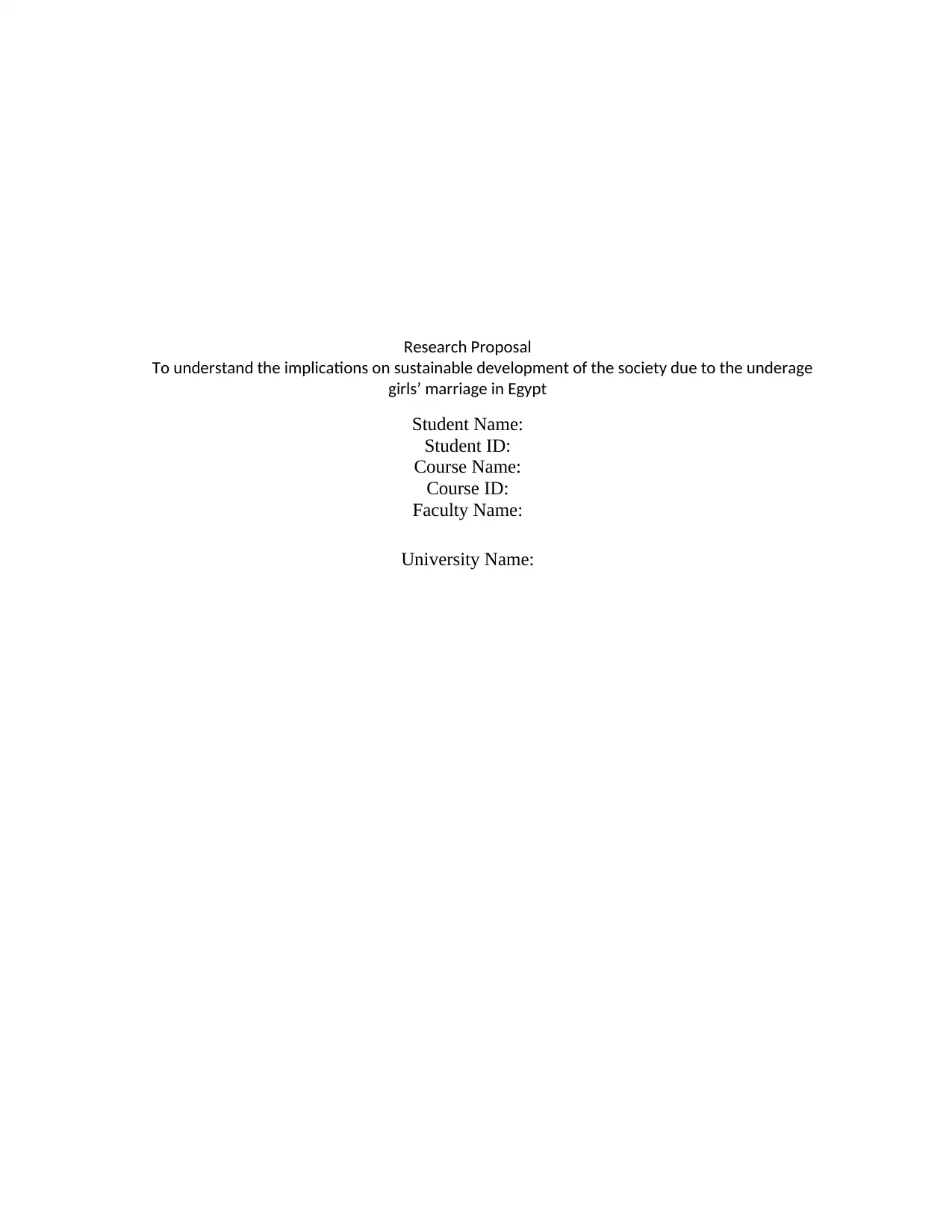
Research Proposal
To understand the implications on sustainable development of the society due to the underage
girls’ marriage in Egypt
Student Name:
Student ID:
Course Name:
Course ID:
Faculty Name:
University Name:
To understand the implications on sustainable development of the society due to the underage
girls’ marriage in Egypt
Student Name:
Student ID:
Course Name:
Course ID:
Faculty Name:
University Name:
Secure Best Marks with AI Grader
Need help grading? Try our AI Grader for instant feedback on your assignments.
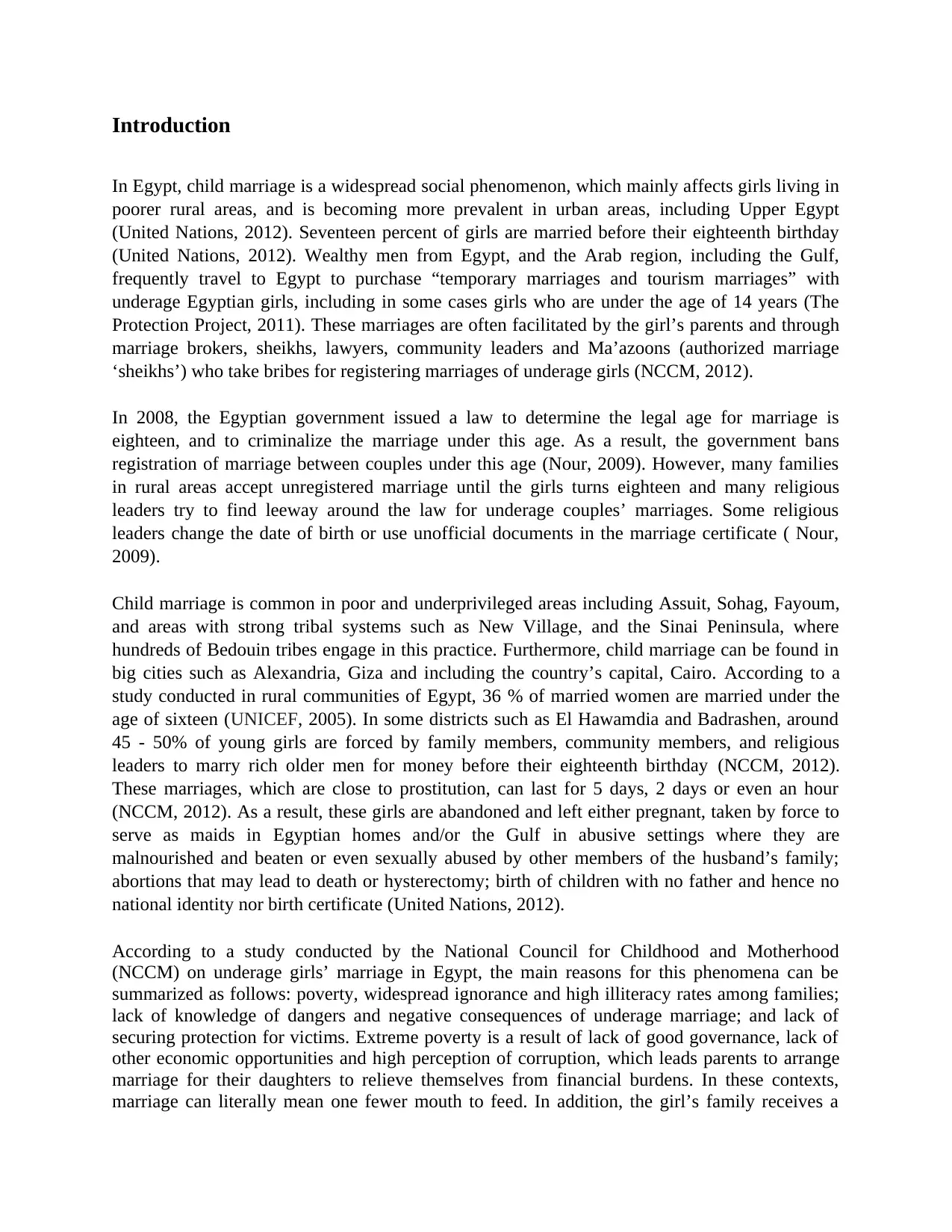
Introduction
In Egypt, child marriage is a widespread social phenomenon, which mainly affects girls living in
poorer rural areas, and is becoming more prevalent in urban areas, including Upper Egypt
(United Nations, 2012). Seventeen percent of girls are married before their eighteenth birthday
(United Nations, 2012). Wealthy men from Egypt, and the Arab region, including the Gulf,
frequently travel to Egypt to purchase “temporary marriages and tourism marriages” with
underage Egyptian girls, including in some cases girls who are under the age of 14 years (The
Protection Project, 2011). These marriages are often facilitated by the girl’s parents and through
marriage brokers, sheikhs, lawyers, community leaders and Ma’azoons (authorized marriage
‘sheikhs’) who take bribes for registering marriages of underage girls (NCCM, 2012).
In 2008, the Egyptian government issued a law to determine the legal age for marriage is
eighteen, and to criminalize the marriage under this age. As a result, the government bans
registration of marriage between couples under this age (Nour, 2009). However, many families
in rural areas accept unregistered marriage until the girls turns eighteen and many religious
leaders try to find leeway around the law for underage couples’ marriages. Some religious
leaders change the date of birth or use unofficial documents in the marriage certificate ( Nour,
2009).
Child marriage is common in poor and underprivileged areas including Assuit, Sohag, Fayoum,
and areas with strong tribal systems such as New Village, and the Sinai Peninsula, where
hundreds of Bedouin tribes engage in this practice. Furthermore, child marriage can be found in
big cities such as Alexandria, Giza and including the country’s capital, Cairo. According to a
study conducted in rural communities of Egypt, 36 % of married women are married under the
age of sixteen (UNICEF, 2005). In some districts such as El Hawamdia and Badrashen, around
45 - 50% of young girls are forced by family members, community members, and religious
leaders to marry rich older men for money before their eighteenth birthday (NCCM, 2012).
These marriages, which are close to prostitution, can last for 5 days, 2 days or even an hour
(NCCM, 2012). As a result, these girls are abandoned and left either pregnant, taken by force to
serve as maids in Egyptian homes and/or the Gulf in abusive settings where they are
malnourished and beaten or even sexually abused by other members of the husband’s family;
abortions that may lead to death or hysterectomy; birth of children with no father and hence no
national identity nor birth certificate (United Nations, 2012).
According to a study conducted by the National Council for Childhood and Motherhood
(NCCM) on underage girls’ marriage in Egypt, the main reasons for this phenomena can be
summarized as follows: poverty, widespread ignorance and high illiteracy rates among families;
lack of knowledge of dangers and negative consequences of underage marriage; and lack of
securing protection for victims. Extreme poverty is a result of lack of good governance, lack of
other economic opportunities and high perception of corruption, which leads parents to arrange
marriage for their daughters to relieve themselves from financial burdens. In these contexts,
marriage can literally mean one fewer mouth to feed. In addition, the girl’s family receives a
In Egypt, child marriage is a widespread social phenomenon, which mainly affects girls living in
poorer rural areas, and is becoming more prevalent in urban areas, including Upper Egypt
(United Nations, 2012). Seventeen percent of girls are married before their eighteenth birthday
(United Nations, 2012). Wealthy men from Egypt, and the Arab region, including the Gulf,
frequently travel to Egypt to purchase “temporary marriages and tourism marriages” with
underage Egyptian girls, including in some cases girls who are under the age of 14 years (The
Protection Project, 2011). These marriages are often facilitated by the girl’s parents and through
marriage brokers, sheikhs, lawyers, community leaders and Ma’azoons (authorized marriage
‘sheikhs’) who take bribes for registering marriages of underage girls (NCCM, 2012).
In 2008, the Egyptian government issued a law to determine the legal age for marriage is
eighteen, and to criminalize the marriage under this age. As a result, the government bans
registration of marriage between couples under this age (Nour, 2009). However, many families
in rural areas accept unregistered marriage until the girls turns eighteen and many religious
leaders try to find leeway around the law for underage couples’ marriages. Some religious
leaders change the date of birth or use unofficial documents in the marriage certificate ( Nour,
2009).
Child marriage is common in poor and underprivileged areas including Assuit, Sohag, Fayoum,
and areas with strong tribal systems such as New Village, and the Sinai Peninsula, where
hundreds of Bedouin tribes engage in this practice. Furthermore, child marriage can be found in
big cities such as Alexandria, Giza and including the country’s capital, Cairo. According to a
study conducted in rural communities of Egypt, 36 % of married women are married under the
age of sixteen (UNICEF, 2005). In some districts such as El Hawamdia and Badrashen, around
45 - 50% of young girls are forced by family members, community members, and religious
leaders to marry rich older men for money before their eighteenth birthday (NCCM, 2012).
These marriages, which are close to prostitution, can last for 5 days, 2 days or even an hour
(NCCM, 2012). As a result, these girls are abandoned and left either pregnant, taken by force to
serve as maids in Egyptian homes and/or the Gulf in abusive settings where they are
malnourished and beaten or even sexually abused by other members of the husband’s family;
abortions that may lead to death or hysterectomy; birth of children with no father and hence no
national identity nor birth certificate (United Nations, 2012).
According to a study conducted by the National Council for Childhood and Motherhood
(NCCM) on underage girls’ marriage in Egypt, the main reasons for this phenomena can be
summarized as follows: poverty, widespread ignorance and high illiteracy rates among families;
lack of knowledge of dangers and negative consequences of underage marriage; and lack of
securing protection for victims. Extreme poverty is a result of lack of good governance, lack of
other economic opportunities and high perception of corruption, which leads parents to arrange
marriage for their daughters to relieve themselves from financial burdens. In these contexts,
marriage can literally mean one fewer mouth to feed. In addition, the girl’s family receives a
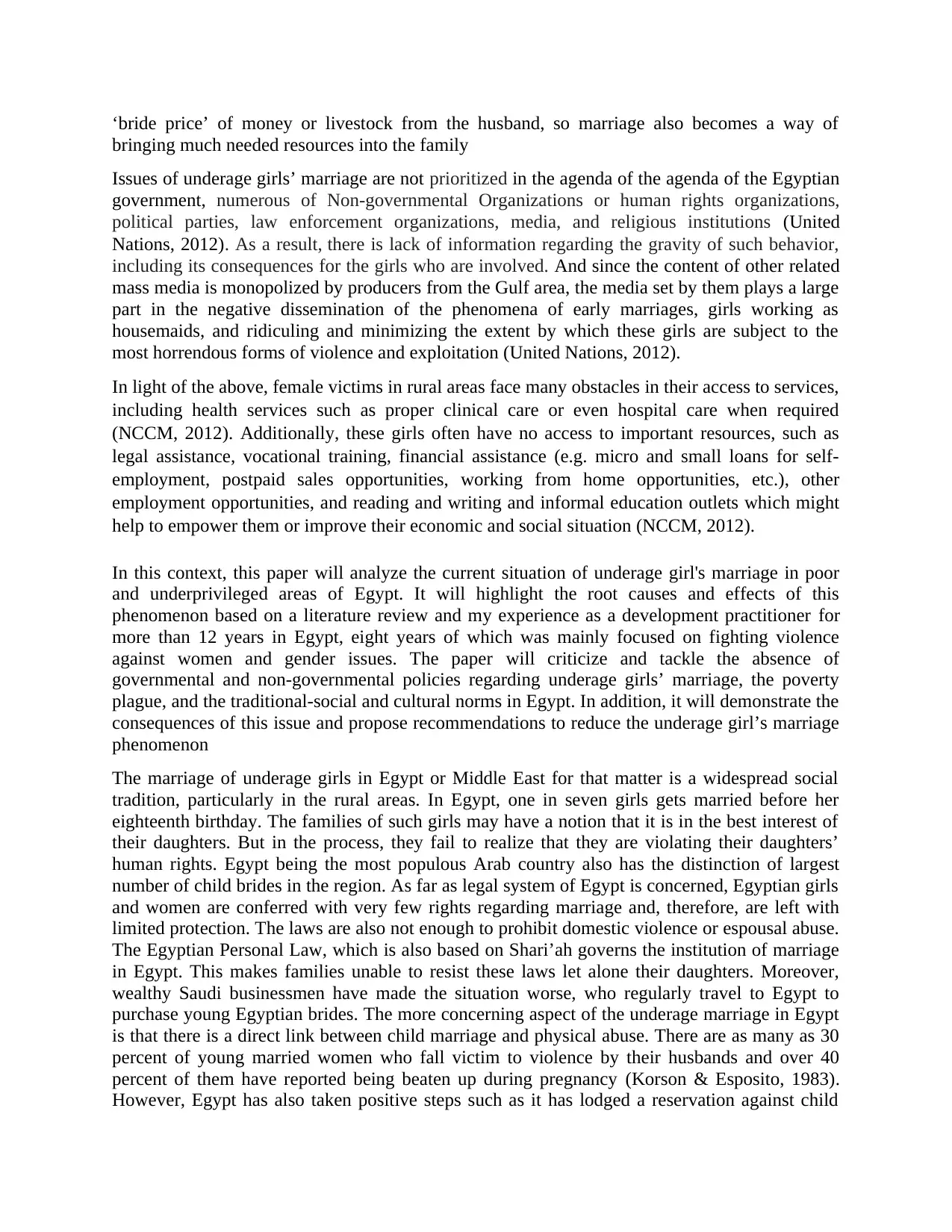
‘bride price’ of money or livestock from the husband, so marriage also becomes a way of
bringing much needed resources into the family
Issues of underage girls’ marriage are not prioritized in the agenda of the agenda of the Egyptian
government, numerous of Non-governmental Organizations or human rights organizations,
political parties, law enforcement organizations, media, and religious institutions (United
Nations, 2012). As a result, there is lack of information regarding the gravity of such behavior,
including its consequences for the girls who are involved. And since the content of other related
mass media is monopolized by producers from the Gulf area, the media set by them plays a large
part in the negative dissemination of the phenomena of early marriages, girls working as
housemaids, and ridiculing and minimizing the extent by which these girls are subject to the
most horrendous forms of violence and exploitation (United Nations, 2012).
In light of the above, female victims in rural areas face many obstacles in their access to services,
including health services such as proper clinical care or even hospital care when required
(NCCM, 2012). Additionally, these girls often have no access to important resources, such as
legal assistance, vocational training, financial assistance (e.g. micro and small loans for self-
employment, postpaid sales opportunities, working from home opportunities, etc.), other
employment opportunities, and reading and writing and informal education outlets which might
help to empower them or improve their economic and social situation (NCCM, 2012).
In this context, this paper will analyze the current situation of underage girl's marriage in poor
and underprivileged areas of Egypt. It will highlight the root causes and effects of this
phenomenon based on a literature review and my experience as a development practitioner for
more than 12 years in Egypt, eight years of which was mainly focused on fighting violence
against women and gender issues. The paper will criticize and tackle the absence of
governmental and non-governmental policies regarding underage girls’ marriage, the poverty
plague, and the traditional-social and cultural norms in Egypt. In addition, it will demonstrate the
consequences of this issue and propose recommendations to reduce the underage girl’s marriage
phenomenon
The marriage of underage girls in Egypt or Middle East for that matter is a widespread social
tradition, particularly in the rural areas. In Egypt, one in seven girls gets married before her
eighteenth birthday. The families of such girls may have a notion that it is in the best interest of
their daughters. But in the process, they fail to realize that they are violating their daughters’
human rights. Egypt being the most populous Arab country also has the distinction of largest
number of child brides in the region. As far as legal system of Egypt is concerned, Egyptian girls
and women are conferred with very few rights regarding marriage and, therefore, are left with
limited protection. The laws are also not enough to prohibit domestic violence or espousal abuse.
The Egyptian Personal Law, which is also based on Shari’ah governs the institution of marriage
in Egypt. This makes families unable to resist these laws let alone their daughters. Moreover,
wealthy Saudi businessmen have made the situation worse, who regularly travel to Egypt to
purchase young Egyptian brides. The more concerning aspect of the underage marriage in Egypt
is that there is a direct link between child marriage and physical abuse. There are as many as 30
percent of young married women who fall victim to violence by their husbands and over 40
percent of them have reported being beaten up during pregnancy (Korson & Esposito, 1983).
However, Egypt has also taken positive steps such as it has lodged a reservation against child
bringing much needed resources into the family
Issues of underage girls’ marriage are not prioritized in the agenda of the agenda of the Egyptian
government, numerous of Non-governmental Organizations or human rights organizations,
political parties, law enforcement organizations, media, and religious institutions (United
Nations, 2012). As a result, there is lack of information regarding the gravity of such behavior,
including its consequences for the girls who are involved. And since the content of other related
mass media is monopolized by producers from the Gulf area, the media set by them plays a large
part in the negative dissemination of the phenomena of early marriages, girls working as
housemaids, and ridiculing and minimizing the extent by which these girls are subject to the
most horrendous forms of violence and exploitation (United Nations, 2012).
In light of the above, female victims in rural areas face many obstacles in their access to services,
including health services such as proper clinical care or even hospital care when required
(NCCM, 2012). Additionally, these girls often have no access to important resources, such as
legal assistance, vocational training, financial assistance (e.g. micro and small loans for self-
employment, postpaid sales opportunities, working from home opportunities, etc.), other
employment opportunities, and reading and writing and informal education outlets which might
help to empower them or improve their economic and social situation (NCCM, 2012).
In this context, this paper will analyze the current situation of underage girl's marriage in poor
and underprivileged areas of Egypt. It will highlight the root causes and effects of this
phenomenon based on a literature review and my experience as a development practitioner for
more than 12 years in Egypt, eight years of which was mainly focused on fighting violence
against women and gender issues. The paper will criticize and tackle the absence of
governmental and non-governmental policies regarding underage girls’ marriage, the poverty
plague, and the traditional-social and cultural norms in Egypt. In addition, it will demonstrate the
consequences of this issue and propose recommendations to reduce the underage girl’s marriage
phenomenon
The marriage of underage girls in Egypt or Middle East for that matter is a widespread social
tradition, particularly in the rural areas. In Egypt, one in seven girls gets married before her
eighteenth birthday. The families of such girls may have a notion that it is in the best interest of
their daughters. But in the process, they fail to realize that they are violating their daughters’
human rights. Egypt being the most populous Arab country also has the distinction of largest
number of child brides in the region. As far as legal system of Egypt is concerned, Egyptian girls
and women are conferred with very few rights regarding marriage and, therefore, are left with
limited protection. The laws are also not enough to prohibit domestic violence or espousal abuse.
The Egyptian Personal Law, which is also based on Shari’ah governs the institution of marriage
in Egypt. This makes families unable to resist these laws let alone their daughters. Moreover,
wealthy Saudi businessmen have made the situation worse, who regularly travel to Egypt to
purchase young Egyptian brides. The more concerning aspect of the underage marriage in Egypt
is that there is a direct link between child marriage and physical abuse. There are as many as 30
percent of young married women who fall victim to violence by their husbands and over 40
percent of them have reported being beaten up during pregnancy (Korson & Esposito, 1983).
However, Egypt has also taken positive steps such as it has lodged a reservation against child
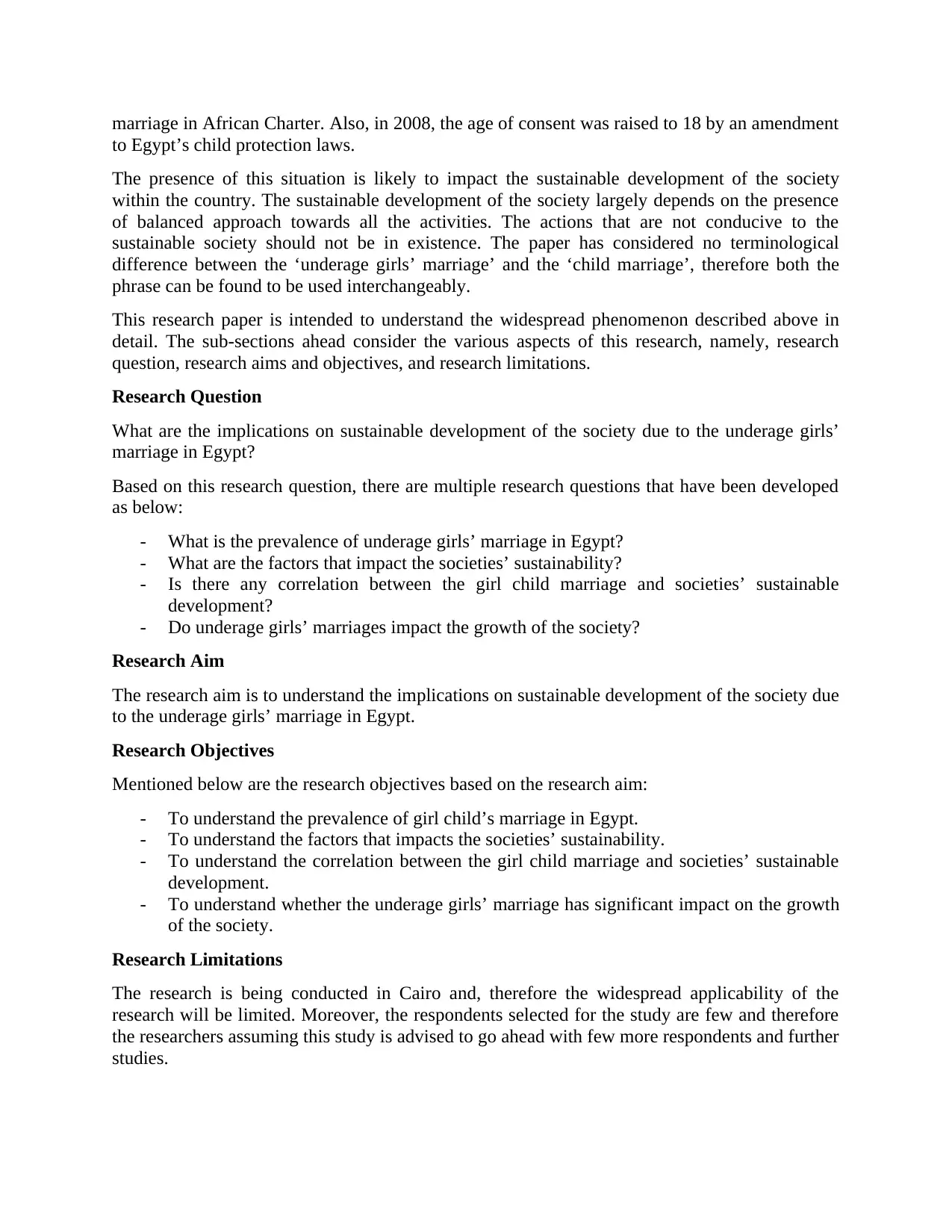
marriage in African Charter. Also, in 2008, the age of consent was raised to 18 by an amendment
to Egypt’s child protection laws.
The presence of this situation is likely to impact the sustainable development of the society
within the country. The sustainable development of the society largely depends on the presence
of balanced approach towards all the activities. The actions that are not conducive to the
sustainable society should not be in existence. The paper has considered no terminological
difference between the ‘underage girls’ marriage’ and the ‘child marriage’, therefore both the
phrase can be found to be used interchangeably.
This research paper is intended to understand the widespread phenomenon described above in
detail. The sub-sections ahead consider the various aspects of this research, namely, research
question, research aims and objectives, and research limitations.
Research Question
What are the implications on sustainable development of the society due to the underage girls’
marriage in Egypt?
Based on this research question, there are multiple research questions that have been developed
as below:
- What is the prevalence of underage girls’ marriage in Egypt?
- What are the factors that impact the societies’ sustainability?
- Is there any correlation between the girl child marriage and societies’ sustainable
development?
- Do underage girls’ marriages impact the growth of the society?
Research Aim
The research aim is to understand the implications on sustainable development of the society due
to the underage girls’ marriage in Egypt.
Research Objectives
Mentioned below are the research objectives based on the research aim:
- To understand the prevalence of girl child’s marriage in Egypt.
- To understand the factors that impacts the societies’ sustainability.
- To understand the correlation between the girl child marriage and societies’ sustainable
development.
- To understand whether the underage girls’ marriage has significant impact on the growth
of the society.
Research Limitations
The research is being conducted in Cairo and, therefore the widespread applicability of the
research will be limited. Moreover, the respondents selected for the study are few and therefore
the researchers assuming this study is advised to go ahead with few more respondents and further
studies.
to Egypt’s child protection laws.
The presence of this situation is likely to impact the sustainable development of the society
within the country. The sustainable development of the society largely depends on the presence
of balanced approach towards all the activities. The actions that are not conducive to the
sustainable society should not be in existence. The paper has considered no terminological
difference between the ‘underage girls’ marriage’ and the ‘child marriage’, therefore both the
phrase can be found to be used interchangeably.
This research paper is intended to understand the widespread phenomenon described above in
detail. The sub-sections ahead consider the various aspects of this research, namely, research
question, research aims and objectives, and research limitations.
Research Question
What are the implications on sustainable development of the society due to the underage girls’
marriage in Egypt?
Based on this research question, there are multiple research questions that have been developed
as below:
- What is the prevalence of underage girls’ marriage in Egypt?
- What are the factors that impact the societies’ sustainability?
- Is there any correlation between the girl child marriage and societies’ sustainable
development?
- Do underage girls’ marriages impact the growth of the society?
Research Aim
The research aim is to understand the implications on sustainable development of the society due
to the underage girls’ marriage in Egypt.
Research Objectives
Mentioned below are the research objectives based on the research aim:
- To understand the prevalence of girl child’s marriage in Egypt.
- To understand the factors that impacts the societies’ sustainability.
- To understand the correlation between the girl child marriage and societies’ sustainable
development.
- To understand whether the underage girls’ marriage has significant impact on the growth
of the society.
Research Limitations
The research is being conducted in Cairo and, therefore the widespread applicability of the
research will be limited. Moreover, the respondents selected for the study are few and therefore
the researchers assuming this study is advised to go ahead with few more respondents and further
studies.
Secure Best Marks with AI Grader
Need help grading? Try our AI Grader for instant feedback on your assignments.
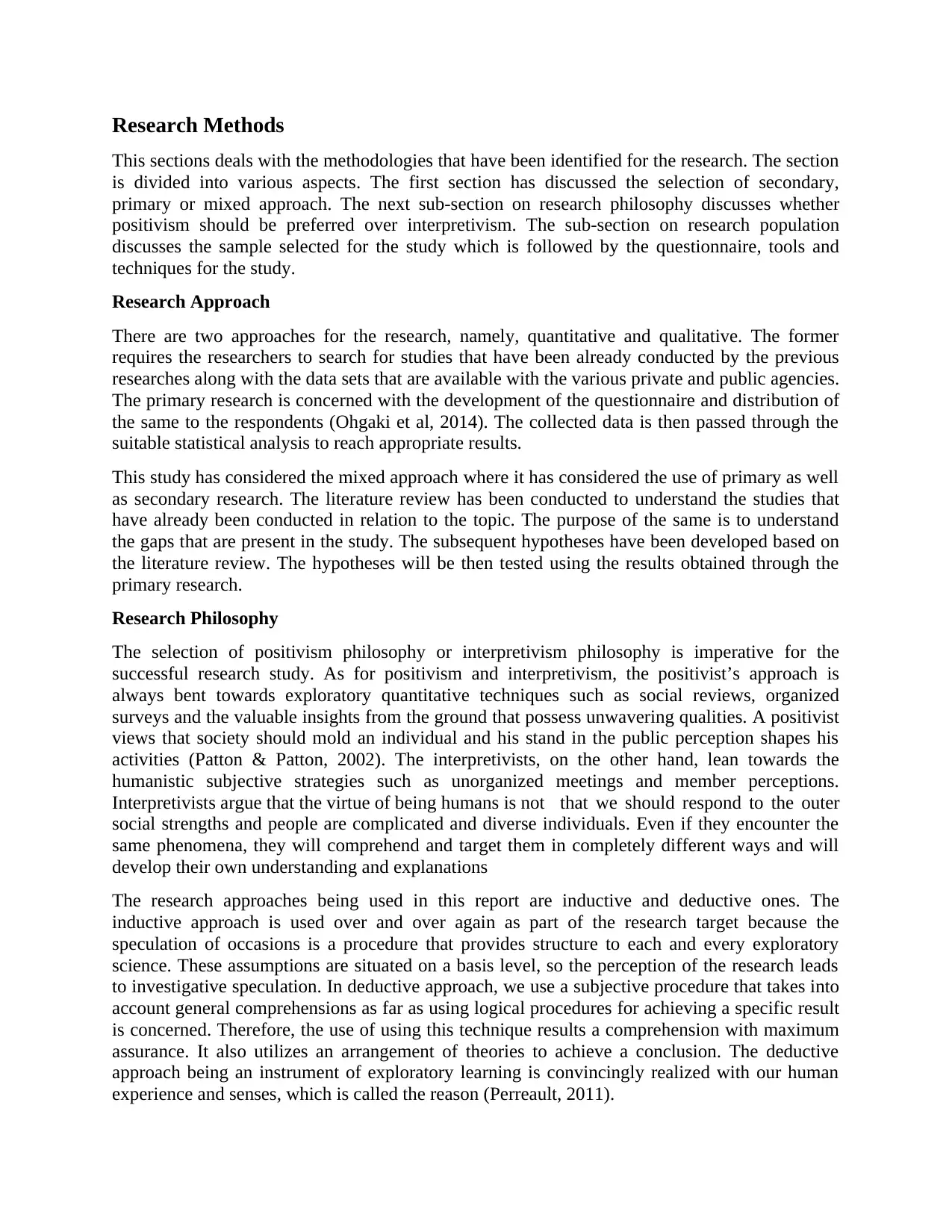
Research Methods
This sections deals with the methodologies that have been identified for the research. The section
is divided into various aspects. The first section has discussed the selection of secondary,
primary or mixed approach. The next sub-section on research philosophy discusses whether
positivism should be preferred over interpretivism. The sub-section on research population
discusses the sample selected for the study which is followed by the questionnaire, tools and
techniques for the study.
Research Approach
There are two approaches for the research, namely, quantitative and qualitative. The former
requires the researchers to search for studies that have been already conducted by the previous
researches along with the data sets that are available with the various private and public agencies.
The primary research is concerned with the development of the questionnaire and distribution of
the same to the respondents (Ohgaki et al, 2014). The collected data is then passed through the
suitable statistical analysis to reach appropriate results.
This study has considered the mixed approach where it has considered the use of primary as well
as secondary research. The literature review has been conducted to understand the studies that
have already been conducted in relation to the topic. The purpose of the same is to understand
the gaps that are present in the study. The subsequent hypotheses have been developed based on
the literature review. The hypotheses will be then tested using the results obtained through the
primary research.
Research Philosophy
The selection of positivism philosophy or interpretivism philosophy is imperative for the
successful research study. As for positivism and interpretivism, the positivist’s approach is
always bent towards exploratory quantitative techniques such as social reviews, organized
surveys and the valuable insights from the ground that possess unwavering qualities. A positivist
views that society should mold an individual and his stand in the public perception shapes his
activities (Patton & Patton, 2002). The interpretivists, on the other hand, lean towards the
humanistic subjective strategies such as unorganized meetings and member perceptions.
Interpretivists argue that the virtue of being humans is not that we should respond to the outer
social strengths and people are complicated and diverse individuals. Even if they encounter the
same phenomena, they will comprehend and target them in completely different ways and will
develop their own understanding and explanations
The research approaches being used in this report are inductive and deductive ones. The
inductive approach is used over and over again as part of the research target because the
speculation of occasions is a procedure that provides structure to each and every exploratory
science. These assumptions are situated on a basis level, so the perception of the research leads
to investigative speculation. In deductive approach, we use a subjective procedure that takes into
account general comprehensions as far as using logical procedures for achieving a specific result
is concerned. Therefore, the use of using this technique results a comprehension with maximum
assurance. It also utilizes an arrangement of theories to achieve a conclusion. The deductive
approach being an instrument of exploratory learning is convincingly realized with our human
experience and senses, which is called the reason (Perreault, 2011).
This sections deals with the methodologies that have been identified for the research. The section
is divided into various aspects. The first section has discussed the selection of secondary,
primary or mixed approach. The next sub-section on research philosophy discusses whether
positivism should be preferred over interpretivism. The sub-section on research population
discusses the sample selected for the study which is followed by the questionnaire, tools and
techniques for the study.
Research Approach
There are two approaches for the research, namely, quantitative and qualitative. The former
requires the researchers to search for studies that have been already conducted by the previous
researches along with the data sets that are available with the various private and public agencies.
The primary research is concerned with the development of the questionnaire and distribution of
the same to the respondents (Ohgaki et al, 2014). The collected data is then passed through the
suitable statistical analysis to reach appropriate results.
This study has considered the mixed approach where it has considered the use of primary as well
as secondary research. The literature review has been conducted to understand the studies that
have already been conducted in relation to the topic. The purpose of the same is to understand
the gaps that are present in the study. The subsequent hypotheses have been developed based on
the literature review. The hypotheses will be then tested using the results obtained through the
primary research.
Research Philosophy
The selection of positivism philosophy or interpretivism philosophy is imperative for the
successful research study. As for positivism and interpretivism, the positivist’s approach is
always bent towards exploratory quantitative techniques such as social reviews, organized
surveys and the valuable insights from the ground that possess unwavering qualities. A positivist
views that society should mold an individual and his stand in the public perception shapes his
activities (Patton & Patton, 2002). The interpretivists, on the other hand, lean towards the
humanistic subjective strategies such as unorganized meetings and member perceptions.
Interpretivists argue that the virtue of being humans is not that we should respond to the outer
social strengths and people are complicated and diverse individuals. Even if they encounter the
same phenomena, they will comprehend and target them in completely different ways and will
develop their own understanding and explanations
The research approaches being used in this report are inductive and deductive ones. The
inductive approach is used over and over again as part of the research target because the
speculation of occasions is a procedure that provides structure to each and every exploratory
science. These assumptions are situated on a basis level, so the perception of the research leads
to investigative speculation. In deductive approach, we use a subjective procedure that takes into
account general comprehensions as far as using logical procedures for achieving a specific result
is concerned. Therefore, the use of using this technique results a comprehension with maximum
assurance. It also utilizes an arrangement of theories to achieve a conclusion. The deductive
approach being an instrument of exploratory learning is convincingly realized with our human
experience and senses, which is called the reason (Perreault, 2011).
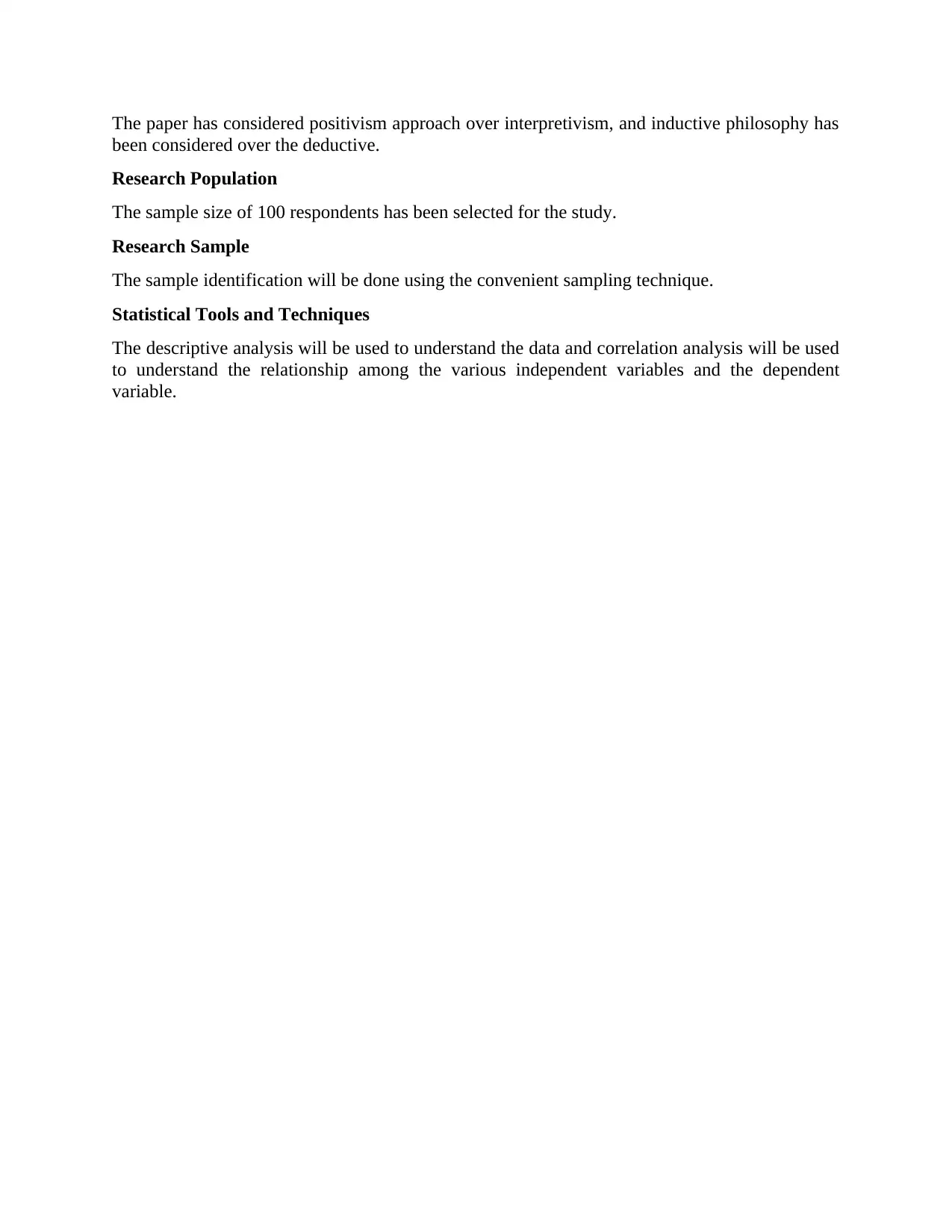
The paper has considered positivism approach over interpretivism, and inductive philosophy has
been considered over the deductive.
Research Population
The sample size of 100 respondents has been selected for the study.
Research Sample
The sample identification will be done using the convenient sampling technique.
Statistical Tools and Techniques
The descriptive analysis will be used to understand the data and correlation analysis will be used
to understand the relationship among the various independent variables and the dependent
variable.
been considered over the deductive.
Research Population
The sample size of 100 respondents has been selected for the study.
Research Sample
The sample identification will be done using the convenient sampling technique.
Statistical Tools and Techniques
The descriptive analysis will be used to understand the data and correlation analysis will be used
to understand the relationship among the various independent variables and the dependent
variable.
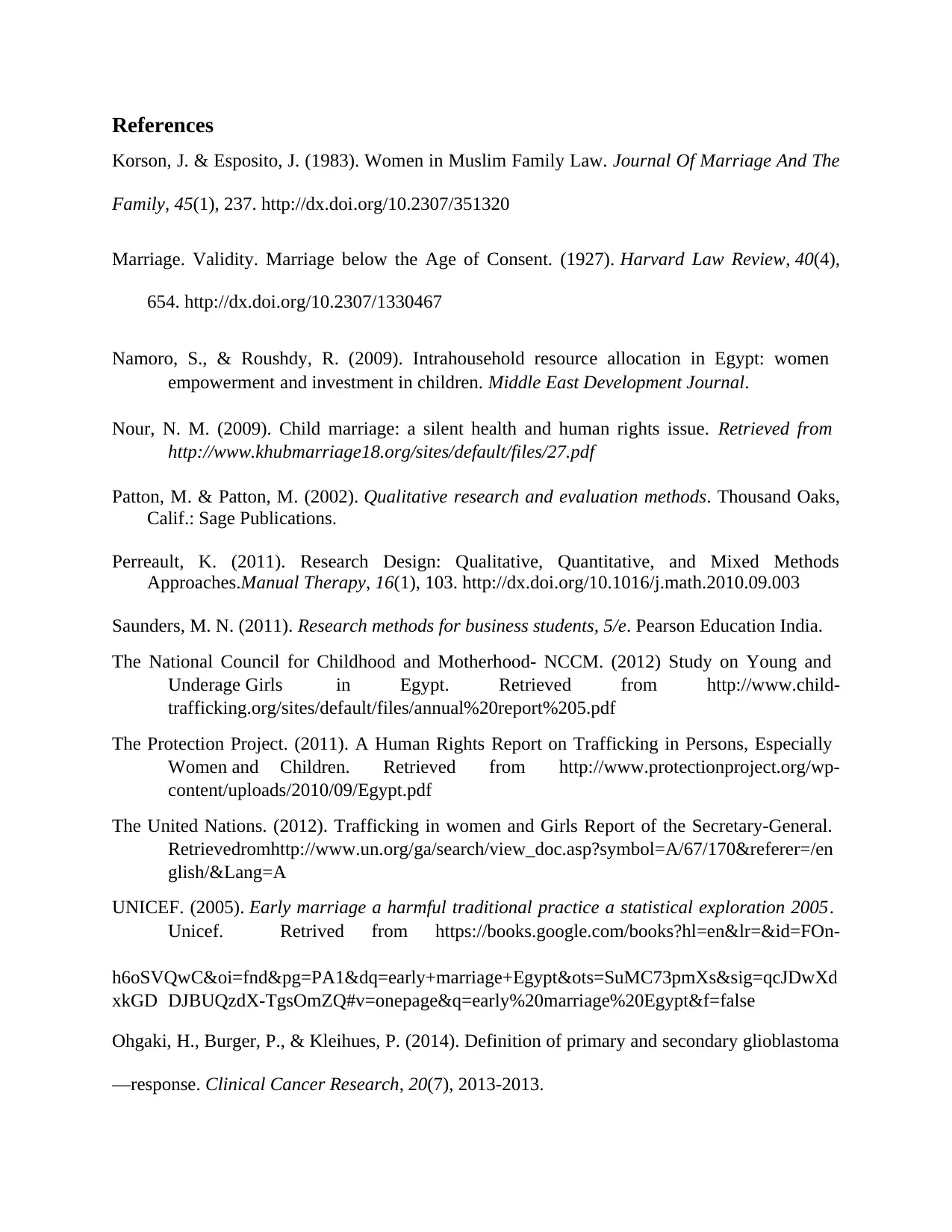
References
Korson, J. & Esposito, J. (1983). Women in Muslim Family Law. Journal Of Marriage And The
Family, 45(1), 237. http://dx.doi.org/10.2307/351320
Marriage. Validity. Marriage below the Age of Consent. (1927). Harvard Law Review, 40(4),
654. http://dx.doi.org/10.2307/1330467
Namoro, S., & Roushdy, R. (2009). Intrahousehold resource allocation in Egypt: women
empowerment and investment in children. Middle East Development Journal.
Nour, N. M. (2009). Child marriage: a silent health and human rights issue. Retrieved from
http://www.khubmarriage18.org/sites/default/files/27.pdf
Patton, M. & Patton, M. (2002). Qualitative research and evaluation methods. Thousand Oaks,
Calif.: Sage Publications.
Perreault, K. (2011). Research Design: Qualitative, Quantitative, and Mixed Methods
Approaches.Manual Therapy, 16(1), 103. http://dx.doi.org/10.1016/j.math.2010.09.003
Saunders, M. N. (2011). Research methods for business students, 5/e. Pearson Education India.
The National Council for Childhood and Motherhood- NCCM. (2012) Study on Young and
Underage Girls in Egypt. Retrieved from http://www.child-
trafficking.org/sites/default/files/annual%20report%205.pdf
The Protection Project. (2011). A Human Rights Report on Trafficking in Persons, Especially
Women and Children. Retrieved from http://www.protectionproject.org/wp-
content/uploads/2010/09/Egypt.pdf
The United Nations. (2012). Trafficking in women and Girls Report of the Secretary-General.
Retrievedromhttp://www.un.org/ga/search/view_doc.asp?symbol=A/67/170&referer=/en
glish/&Lang=A
UNICEF. (2005). Early marriage a harmful traditional practice a statistical exploration 2005.
Unicef. Retrived from https://books.google.com/books?hl=en&lr=&id=FOn-
h6oSVQwC&oi=fnd&pg=PA1&dq=early+marriage+Egypt&ots=SuMC73pmXs&sig=qcJDwXd
xkGD DJBUQzdX-TgsOmZQ#v=onepage&q=early%20marriage%20Egypt&f=false
Ohgaki, H., Burger, P., & Kleihues, P. (2014). Definition of primary and secondary glioblastoma
—response. Clinical Cancer Research, 20(7), 2013-2013.
Korson, J. & Esposito, J. (1983). Women in Muslim Family Law. Journal Of Marriage And The
Family, 45(1), 237. http://dx.doi.org/10.2307/351320
Marriage. Validity. Marriage below the Age of Consent. (1927). Harvard Law Review, 40(4),
654. http://dx.doi.org/10.2307/1330467
Namoro, S., & Roushdy, R. (2009). Intrahousehold resource allocation in Egypt: women
empowerment and investment in children. Middle East Development Journal.
Nour, N. M. (2009). Child marriage: a silent health and human rights issue. Retrieved from
http://www.khubmarriage18.org/sites/default/files/27.pdf
Patton, M. & Patton, M. (2002). Qualitative research and evaluation methods. Thousand Oaks,
Calif.: Sage Publications.
Perreault, K. (2011). Research Design: Qualitative, Quantitative, and Mixed Methods
Approaches.Manual Therapy, 16(1), 103. http://dx.doi.org/10.1016/j.math.2010.09.003
Saunders, M. N. (2011). Research methods for business students, 5/e. Pearson Education India.
The National Council for Childhood and Motherhood- NCCM. (2012) Study on Young and
Underage Girls in Egypt. Retrieved from http://www.child-
trafficking.org/sites/default/files/annual%20report%205.pdf
The Protection Project. (2011). A Human Rights Report on Trafficking in Persons, Especially
Women and Children. Retrieved from http://www.protectionproject.org/wp-
content/uploads/2010/09/Egypt.pdf
The United Nations. (2012). Trafficking in women and Girls Report of the Secretary-General.
Retrievedromhttp://www.un.org/ga/search/view_doc.asp?symbol=A/67/170&referer=/en
glish/&Lang=A
UNICEF. (2005). Early marriage a harmful traditional practice a statistical exploration 2005.
Unicef. Retrived from https://books.google.com/books?hl=en&lr=&id=FOn-
h6oSVQwC&oi=fnd&pg=PA1&dq=early+marriage+Egypt&ots=SuMC73pmXs&sig=qcJDwXd
xkGD DJBUQzdX-TgsOmZQ#v=onepage&q=early%20marriage%20Egypt&f=false
Ohgaki, H., Burger, P., & Kleihues, P. (2014). Definition of primary and secondary glioblastoma
—response. Clinical Cancer Research, 20(7), 2013-2013.
1 out of 7
Your All-in-One AI-Powered Toolkit for Academic Success.
+13062052269
info@desklib.com
Available 24*7 on WhatsApp / Email
![[object Object]](/_next/static/media/star-bottom.7253800d.svg)
Unlock your academic potential
© 2024 | Zucol Services PVT LTD | All rights reserved.


